Moderate overlap front: original test
Rating applies to 2002-05 models built after March 2002
Tested vehicle: 2002 Kia Sedona LX
The Kia Sedona was introduced in the 2002 model year. Kia says it changed the frontal airbag system for 2002-05 models built after March 2002 (see details below). A redesigned Sedona was introduced as a 2006 model.
| Evaluation criteria | Rating |
|---|---|
| Overall evaluation | |
| Structure and safety cage | |
| Driver injury measures | |
| Head/neck | |
| Chest | |
| Leg/foot, left | |
| Leg/foot, right | |
| Driver restraints and dummy kinematics Dummy movement wasn't well controlled. There was too much upward steering wheel movement. During rebound, the dummy's head moved partway out the open side window and hit the B-pillar. Also, in a separate 5 mph frontal impact without dummies in the car, both frontal airbags deployed. Such deployments not only are unnecessary in low-speed crashes but also may cause injuries to front-seat occupants positioned too close to the airbags. Note: Kia says it changed the airbag system for 2002 and later models built after March 2002 so that the airbags will no longer deploy in such a low-speed impact. Therefore, the restraints/dummy kinematics rating improves to MARGINAL for the later models. | |
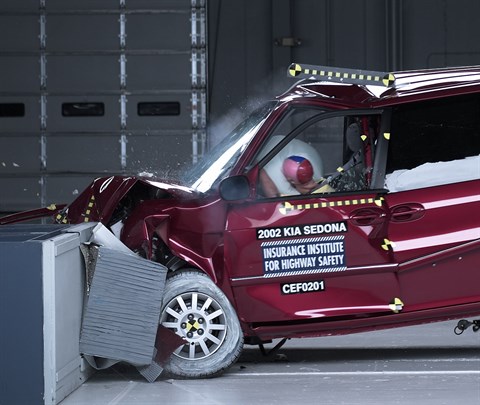
Action shot taken during the frontal offset crash test.

Despite some buckling of the A-pillar and roof rail, the dummy's position in relation to the steering wheel and instrument panel after the crash test indicates the driver's survival space was maintained reasonably well.

The steering wheel moved upward too much during the crash test.

Smeared greasepaint indicates where the dummy's head hit the B-pillar and shoulder belt anchorage during rebound, producing a high head acceleration.
Rating applies to 2002 models built before April 2002
Tested vehicle: 2002 Kia Sedona LX
The Kia Sedona was introduced in the 2002 model year. Kia says it changed the frontal airbag system for 2002 and later models built after March 2002 (see details below).
| Evaluation criteria | Rating |
|---|---|
| Overall evaluation | |
| Structure and safety cage | |
| Driver injury measures | |
| Head/neck | |
| Chest | |
| Leg/foot, left | |
| Leg/foot, right | |
| Driver restraints and dummy kinematics Dummy movement wasn't well controlled. There was too much upward steering wheel movement. During rebound, the dummy's head moved partway out the open side window and hit the B-pillar. Also, in a separate 5 mph frontal impact without dummies in the car, both frontal airbags deployed. Such deployments not only are unnecessary in low-speed crashes but also may cause injuries to front-seat occupants positioned too close to the airbags. Note: Kia says it changed the airbag system for 2002 and later models built after March 2002 so that the airbags will no longer deploy in such a low-speed impact. Therefore, the restraints/dummy kinematics rating improves to MARGINAL for the later models. | |
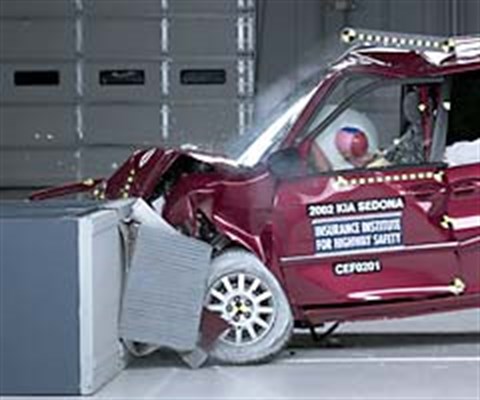
Action shot taken during the frontal offset crash test
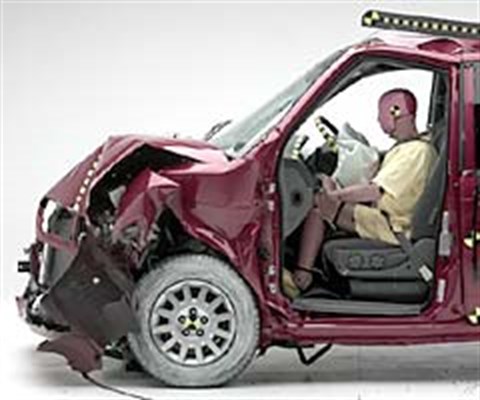
Despite some buckling of the A-pillar and roof rail, the dummy's position in relation to the steering wheel and instrument panel after the crash test indicates the driver's survival space was maintained reasonably well.
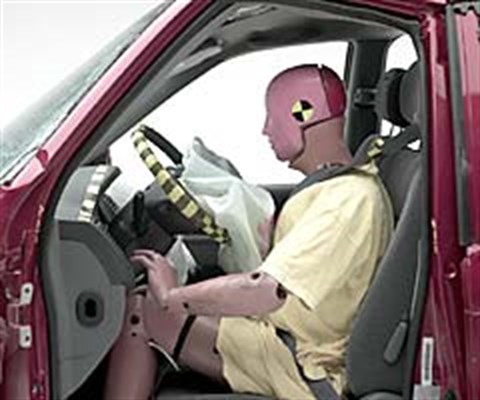
The steering wheel moved upward too much during the crash test.
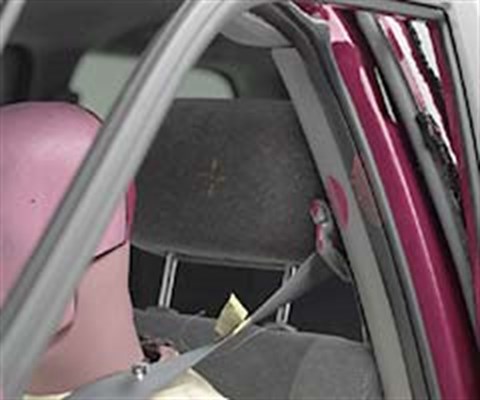
Smeared greasepaint indicates where the dummy's head hit the B-pillar and shoulder belt anchorage during rebound, producing a high head acceleration.
